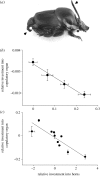Phenotypic plasticity and diversity in insects
- PMID: 20083635
- PMCID: PMC2817146
- DOI: 10.1098/rstb.2009.0263
Phenotypic plasticity and diversity in insects
Abstract
Phenotypic plasticity in general and polyphenic development in particular are thought to play important roles in organismal diversification and evolutionary innovation. Focusing on the evolutionary developmental biology of insects, and specifically that of horned beetles, I explore the avenues by which phenotypic plasticity and polyphenic development have mediated the origins of novelty and diversity. Specifically, I argue that phenotypic plasticity generates novel targets for evolutionary processes to act on, as well as brings about trade-offs during development and evolution, thereby diversifying evolutionary trajectories available to natural populations. Lastly, I examine the notion that in those cases in which phenotypic plasticity is underlain by modularity in gene expression, it results in a fundamental trade-off between degree of plasticity and mutation accumulation. On one hand, this trade-off limits the extent of plasticity that can be accommodated by modularity of gene expression. On the other hand, it causes genes whose expression is specific to rare environments to accumulate greater variation within species, providing the opportunity for faster divergence and diversification between species, compared with genes expressed across environments. Phenotypic plasticity therefore contributes to organismal diversification on a variety of levels of biological organization, thereby facilitating the evolution of novel traits, new species and complex life cycles.
Figures



Similar articles
-
Genomic sources of phenotypic novelty in the evolution of eusociality in insects.Curr Opin Insect Sci. 2016 Feb;13:24-32. doi: 10.1016/j.cois.2015.10.009. Epub 2015 Nov 12. Curr Opin Insect Sci. 2016. PMID: 27436550 Review.
-
Toward a population genetic framework of developmental evolution: the costs, limits, and consequences of phenotypic plasticity.Bioessays. 2010 Jan;32(1):71-81. doi: 10.1002/bies.200900132. Bioessays. 2010. PMID: 20020499 Free PMC article. Review.
-
Rapid evolution of a polyphenic threshold.Evol Dev. 2003 May-Jun;5(3):259-68. doi: 10.1046/j.1525-142x.2003.03033.x. Evol Dev. 2003. PMID: 12752765
-
Nutrition-responsive gene expression and the developmental evolution of insect polyphenism.Nat Ecol Evol. 2020 Jul;4(7):970-978. doi: 10.1038/s41559-020-1202-x. Epub 2020 May 18. Nat Ecol Evol. 2020. PMID: 32424280
-
Genetic assimilation: a review of its potential proximate causes and evolutionary consequences.Ann Bot. 2016 Apr;117(5):769-79. doi: 10.1093/aob/mcv130. Epub 2015 Sep 10. Ann Bot. 2016. PMID: 26359425 Free PMC article. Review.
Cited by
-
Physiological Perturbation Reveals Modularity of Eyespot Development in the Painted Lady Butterfly, Vanessa cardui.PLoS One. 2016 Aug 25;11(8):e0161745. doi: 10.1371/journal.pone.0161745. eCollection 2016. PLoS One. 2016. PMID: 27560365 Free PMC article.
-
Adaptation by death? Cell death-based tolerance to cadmium in 150-generation exposure of Spodoptera exiqua Hübner (Lepidoptera: Noctuidae).Environ Entomol. 2023 Dec 15;52(6):1057-1070. doi: 10.1093/ee/nvad077. Environ Entomol. 2023. PMID: 37804089 Free PMC article.
-
Highly polygenic variation in environmental perception determines dauer larvae formation in growing populations of Caenorhabditis elegans.PLoS One. 2014 Nov 13;9(11):e112830. doi: 10.1371/journal.pone.0112830. eCollection 2014. PLoS One. 2014. PMID: 25393108 Free PMC article.
-
Epigenetic Diversity Underlying Seasonal and Annual Variations in Brown Planthopper (BPH) Populations as Revealed by Methylation- sensitive Restriction Assay.Curr Genomics. 2023 Dec 28;24(6):354-367. doi: 10.2174/0113892029276542231205065843. Curr Genomics. 2023. PMID: 38327650 Free PMC article.
-
Interactions among morphotype, nutrition, and temperature impact fitness of an invasive fly.Ecol Evol. 2019 Feb 3;9(5):2615-2628. doi: 10.1002/ece3.4928. eCollection 2019 Mar. Ecol Evol. 2019. PMID: 31061698 Free PMC article.
References
-
- Abouheif E., Wray G. A.2002Evolution of the gene network underlying wing polyphenism in ants. Science 297, 249–252 (doi:10.1126/science.1071468) - DOI - PubMed
-
- Arrow G. H.1951Horned beetles The Hague, The Netherlands: Junk
-
- Balthasar V.1963Monographie der Scarabaeidae und Aphodiidae der palaearktischen und orientalischen Region (Coleoptera: Lamellicornia). Band 2, Coprinae. Prag: Verlag der tschechoslowakischen Akademie der Wissenschaften
-
- Barker M. S., Demuth J. P., Wade M. J.2005Maternal expression relaxes constraint on innovation of the anterior determinant, bicoid. PloS Genet. 1, 527–530 (doi:10.1371/journal.pgen.0010057) - DOI - PMC - PubMed
-
- Bradshaw W. E., Quebodeaux M. C., Holzapfel C. M.2003Circadian rhythmicity and photoperiodism in the pitcher-plant mosquito: adaptive rsponse to the photic environment or correlated response to climatic adaptation? Am. Nat. 161, 735–748 (doi:10.1086/374344) - DOI - PubMed
Publication types
MeSH terms
LinkOut - more resources
Full Text Sources

